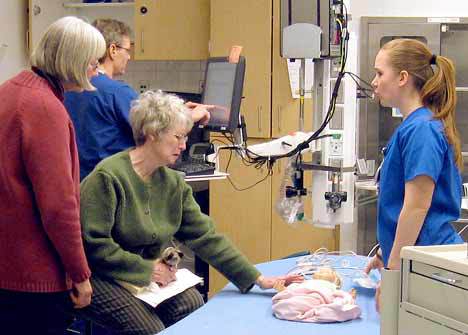She sat there, a counselor standing at her side, in tears, worried about her gravely ill grandchild in the emergency room at Valley Medical Center.
It was an emotional time for Judy Findlay, the grandmother of four, all 7 or younger. She clutched a small stuffed cat.
But the “child” she touched on the bed in front of her was a doll. Still, if she needed motivation she only need think of her real grandkids in such a life-threatening situation.
Findlay of Kent was one of 10 actors hired by the designers of the hospital’s new seven-story Emergency Services Tower to make 32 emergencies as real as possible for the emergency room’s staff.
The simulations were done for eight days before the opening of the hospital’s new emergency room early Thursday morning. About 100 volunteers also participated in supporting roles, such as family members.
“I am very proud of them,” Findlay said of the staff. “This is a very difficult job.”
The simulations were scripted by NBBJ, which designed the recent major expansion of Valley Medical Center, including the $115 million South Tower which houses the Emergency Department.
“This is not about testing the staff’s competence,” said Lynne Shira, an NBBJ principal. “This is about getting them comfortable with their new environment.”
And it was about testing the performance of the new building in order to do fine-tuning before it actually opened, said Jacob Simons, an NBBJ designer, camera around his neck, who watched closely as the scenarios unfolded.
The building, Simons said, is performing “wonderfully.”
This is also the first time that NBBJ has done a full simulation with professional actors, as an effort to make the exercise “as real as possible,” Shira said.
The emergency room staff, about 150 strong, participated in the simulations. The staff includes technicians, nurses and doctors, crisis counselors, security, maintenance and housekeeping.
Some of the actors “arrived” by medic unit, staffed by Renton fire crews, in the covered ambulance bay visible from South 43rd Street
Actor Ben Gonia got a plum role as a belligerent drunk. He laid quietly in the medic unit while he was checked over. That changed when he got inside the ER.
His friend, played by Nick Edwards, became a test for security when he tried to get Gonia off the stretcher. Gonia’s belligerence kicked in.
It took several guards and ER staff to get Gonia under control in an isolation room. He was placed in restraints. “This is to keep you safe,” a nurse told him, and everyone else.
Edwards sat next door in the Family Room talking to a counselor.
A nurse used her cell phone to call a doctor.
One of they key tests of the scenarios is to get staff used to communicating with something other than their voices. There was just one nurses station in the old ER, so everyone worked in close quarters.
But the new ER has four nurses stations spread out over the length of the facility, so technology will help keep staff connected.
Keeping a close eye on the simulations was Scott Alleman, the hospital’s senior vice president for patient-care services.
“I am looking at everything,” he said. He starts thinking about the patients and their families the minute they enter the hospital’s campus.
The simulations were designed to test the assumptions about how the new ER would work.
“You have to find out whether what you thought would work really works,” he said.
The hospital has done simulations in the past, just not with actors, he said. The actors added realism. “It was a shock the first day,” he said.
The simulations help staff become “emotionally girded” for the first day, he said.
Because of the nature of their jobs, the ER staff is trained to deal with uncertainty. They already know how to keep the adrenaline rush under control.
“We are ready,” Alleman said. “Just bring it on.”
Talk to us
Please share your story tips by emailing editor@kentreporter.com.
To share your opinion for publication, submit a letter through our website https://www.kentreporter.com/submit-letter/. Include your name, address and daytime phone number. (We’ll only publish your name and hometown.) Please keep letters to 300 words or less.

